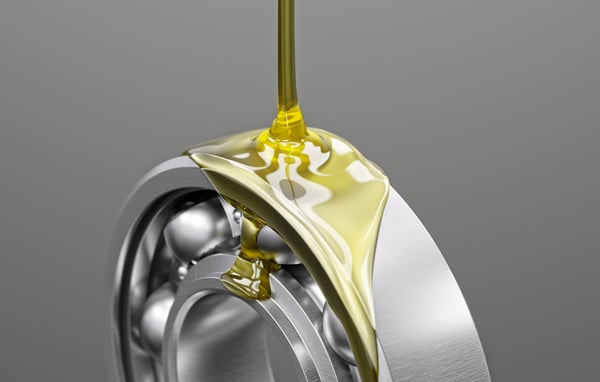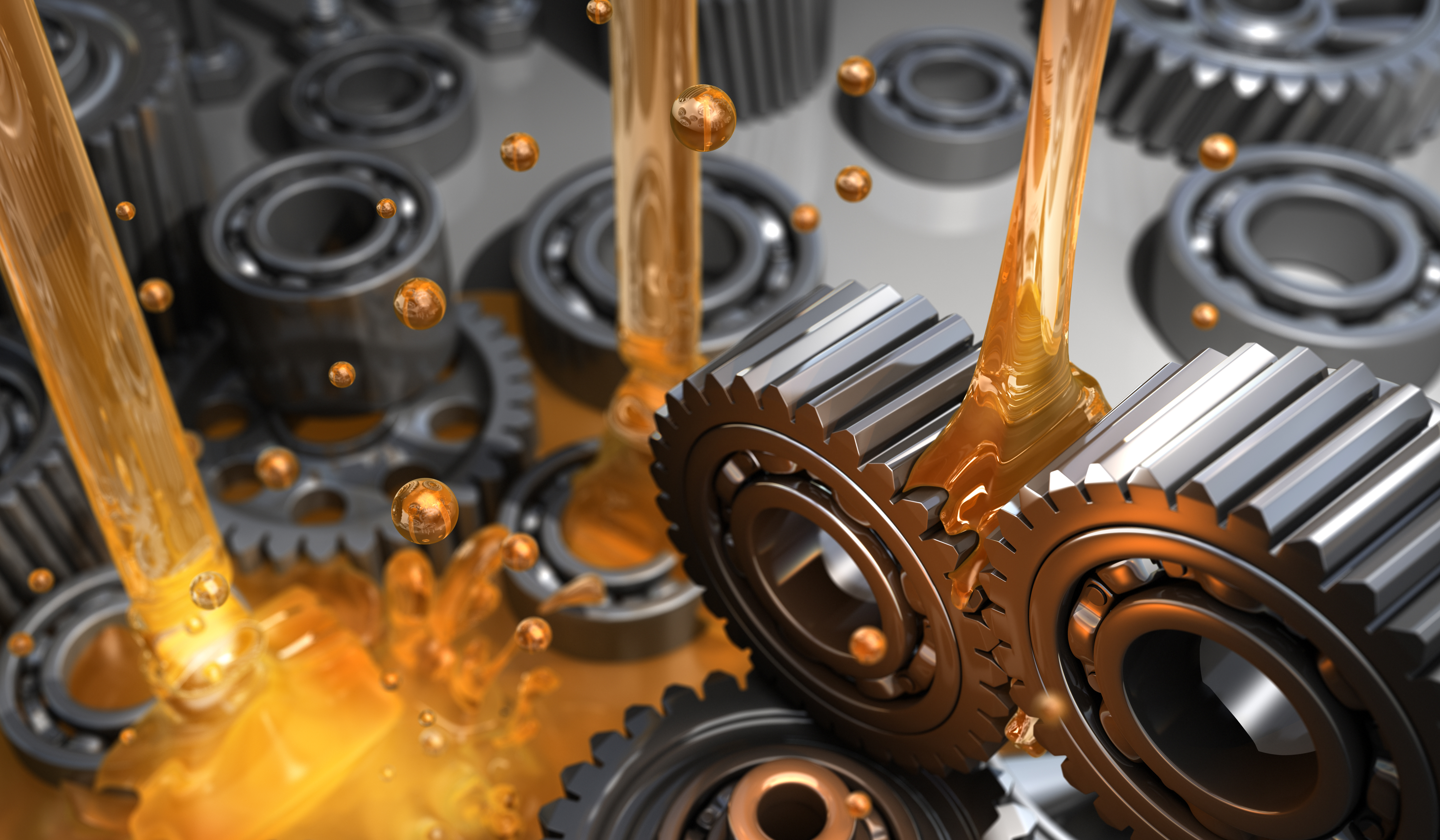Precision is the key to minimizing friction in transmission, and bearing lubrication is the answer to ensuring the rolling component keeps on rolling. There are many reasons for bearing failure, from overloading to improper mounting. But lubrication can also be a contributor when using the wrong type, applying it incorrectly or not providing the correct preventative maintenance.
To learn more about bearing failure and its reasons, read our other blog “What Causes Roller Bearings to Fail and Break?”.
Why Lubrication is so Important for Bearings
Lubrication doesn’t have the sole role of ensuring the smooth and continued running of power transmission in mechanical operation. Lubrication also allows for a barrier between components within the bearing, such as the rolling element, the outer ring, the inner ring and the shield, where required. And, this barrier has several benefits that help with the longevity of your bearing, the other components in your machine and the overall production line.
The role of lubrication in your bearing:- It prevents oxidization
- It minimizes corrosion
- It acts as a contaminant barrier
- It reduces component friction
- It decreases usage wear
- It stabilizes the bearing structure
The 3 Types of Bearing Lubricants
Lubrication must be selected for your bearing while considering the load type, the material and the adjoining components. This is because some lubricants face heavy affection from environmental factors and others cannot resist speeds needed for certain operations. Notably, lubrication is required for any bearing brand, whether that is SKF Bearings or another selection from your bearing supplier of Singapore. So, it’s important to be aware of the three lubrication types based on their viscosity and base material.
1. Grease Lubricant

Grease lubricant features an oil base with an additional thickener allowing the grease to range from fluid to a semi-solid state. With this, it offers varied applications for your bearing and doesn’t need a high-rate maintenance schedule. However, as a partial-solid lubricant, it can’t handle high-load speeds or off-kilter mounting. That said, the additional properties of grease help to provide more protection against corrosion and oxidization.
To learn more about bearing grease selection, visit our other blog “Choosing the Right Grease for Your Bearings”.
2. Oil Lubricant

In opposition to grease lubricant, petroleum-based or synthetic oil can take high load speeds and load capacities, making it a suitable option for high-production mechanical operations while helping to prevent costly downtime. That said, oil is a highly fluid liquid prone to evaporation where the bearing isn’t encased with a shield. With this, it requires a consistent maintenance schedule featuring a range of application methods such as the use of jets and oil baths.
3. Solid Film Lubricant (Dry Lubricant)
.jpg?width=600&name=Solid%20Film%20Lubricant%20(Dry%20Lubricant).jpg)
A final option for bearing lubrication is the solid film lubricant. Popular choices include graphite, boron nitride, molybdenum disulphide or tungsten disulphide and can be burnished or sputtered onto your bearing to create a solid film in the raceways and balls. However, these are typically the last resort selection used for harsh vacuum-sealed or radioactive environments.
Things to Consider When Selecting a Lubricant
When selecting one of the 3 bearing lubricants for your mechanical operations and power transmissions components, there are a few aspects to consider.
The first is the operating temperature of your mechanical appliance; with high speeds or high loads comes high heat and the lubricant must be able to withstand this temperature. As oil lubricant is prone to evaporation without a shield, grease may be a more suitable option if the external conditions and contaminants allow it.
The second consideration is the speed of the bearing and the friction maintenance it requires to prescribe under those conditions. Grease cannot withstand high speeds while both petroleum-based and synthetic oils offer the required protection for your bearings sourced from the bearing supplier of Singapore.
The third factor is the condition of your mechanical operation; where harsh conditions such as a high-contamination, radioactive or vacuum environment are present, it’s crucial to resist downtime by selecting lubrication able to withstand these conditions. The result would be to burnish the bearing components with a solid film of dry lubricant.
The viscosity of the lubricant under operational speeds and temperatures must also be a consideration. Oils, greases and dry lubricants may polymerize in transmission causing the lubricant to develop uneven tacky layers that act as a “speed bump”. This reduces frictionless movement and can cause unnecessary downtime. Therefore, it’s vital to apply lubricants withstanding 148°C (300°F) where required.
Finally, there’s the application of lubrication upon initial installation or maintenance through the operation. Grease may be applied by hand while other lubrications require precision tools and methods such as syringes, oil baths and burnishing tools. This is a vital consideration regardless of the bearing manufacturer, whether that be Koyo Bearings, NIS Bearings or any other.
3 Best Practices for Lubrication Application
Bearing lubrication is a consistent consideration when looking to improve mechanical operations and reduce downtime. That said, there are three best practices from prior installation to post-management for your bearing, no matter the industry or application.
1. Select the Correct Lubricant
The first best practice is to be able to carefully select the correct precision component to provide frictionless power transmission reliably and efficiently for your applied device. This pertains to the lubrication type, the environment, the application, the bearing type and the bearing manufacturer sourced by the bearing supplier of Singapore.
2. Apply the Lubricant Correctly
After sourcing the correct lubricant, it’s vital to be aware of the application process and the viability of your lubrication choice with your application abilities. As some lubricants require precision tools, your choice may also require the help of full-service professionals such as the SLSPRO team here at SLS Bearings. Not only do we source high-quality bearings, but we can also install them correctly.
To learn about correct grease application, click through to our other article “Bearing Maintenance Best Practice: Packing a Tapered Roller Bearing with Grease”.
3. Correctly Maintain the Lubricant
Finally, once in production, your bearing may be subject to lubricant loss or lubricant contamination. Loss occurs with bearing misalignment and through oil evaporation. Contamination occurs when the lubricant encounters surrounding environmental elements such as dust or debris. With an optimal preventive maintenance schedule, your lubrication can offer lasting protection to your bearing.
To find out more about preventive maintenance, read “Providing Predictive Maintenance for Electric Motors”.
That concludes our professional introduction to the importance of lubrication in bearings and other components
From material and application to maintain and best practices; there’s a considerable number of factors to have at the forefront of effective bearing protection.
At SLS, our team are on hand to source the highest of quality bearings from manufacturers around the globe including SKF Bearings, Koyo Bearings, NIS Bearings and many others. In addition, our service experts in our SLSPRO team help to install and maintain your bearings to ensure lasting operations for friction management across mechanical components.
SLS provides a range of lubricants and grease products, if you would like to know more information about these products or would like to know more about lubrication solutions, click below:








